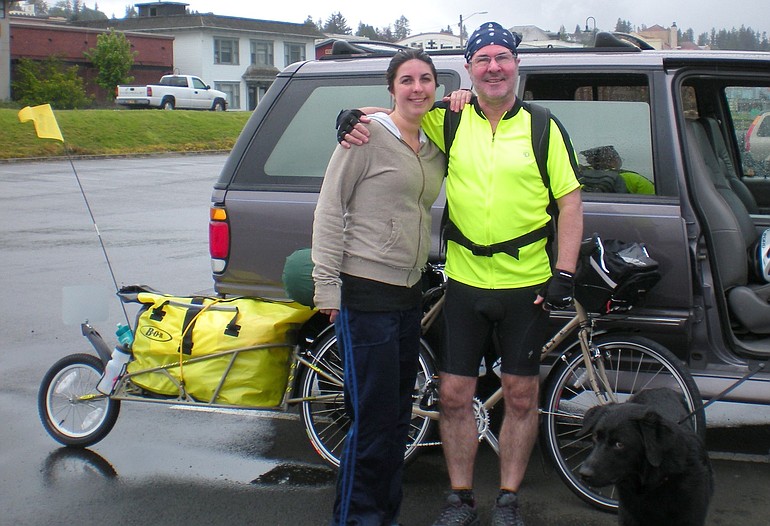When David Jones did the final tally on his coast-to-coast trek, it added up to 3.1 million revolutions for a 26-inch bicycle wheel.
It makes for an impressive number, but Jones likes to break down his 4,022-mile journey into another set of numbers.
“I got on a bicycle and I rode it a mile. I did that 45 times each day, for 89 days,” Jones said.
It’s a more approachable way to view a challenge, Jones said, and it’s a concept that resonated with him along the route.
“People would say, ‘Oh, I could never do that.’ It was kind of sad,” the 55-year-old Jones said.
He knew those people were taking that same approach — “I could never do that” — to other challenges and opportunities in their lives, Jones said.
“It was 4,022 miles, but you ride them one at a time,” after returning home to Vancouver.
When Jones is ready to get back to work, he and a friend will launch an Internet marketing business, he said.
Jones started his trip almost six months ago at the Pacific Ocean, when his daughter, Jennifer, dropped him off in Astoria, Ore. He reached the Atlantic Ocean on Oct. 10 after rolling through Wilmington, N.C.
It wasn’t just miles that separated those two points. There was a steep learning curve, as well as a fitness curve, Jones said.
“I wasn’t a cyclist when I left. My longest ride had been 15 miles,” he said. “When you’re on Oregon 101, in the rain, with log trucks, you learn quickly.”
From the Pacific to the Rocky Mountains “was very physically demanding,” he said, with a net climb of 11,582 feet. “A couple of times, I thought I’d bit off more than I could chew.”
And that didn’t include an unexpected twist. One night in the mountains of eastern Oregon, he set his sweat-drenched bicycle shorts on the floor of his tent and awoke to a slab of ice.
“Nothing like putting on frozen bike shorts in the morning,” he said.
When Jones hit Baker City, Ore., he lightened the load in his bicycle trailer by mailing 18 pounds (and 3 ounces) of supplies back home.
The other side of the Rockies wasn’t exactly all downhill — from a comfort standpoint, anyway.
“The heat index in Kansas was intolerable,” he said. Jones would beat the heat by riding at night.
“The worst road kill in the world is armadillo,” he said. “In Missouri, I saw hundreds of them.”
They weren’t the only casualties he saw in that region.
“Middle America is dying,” he said. “I’d ride through town, and Main Street would virtually be shuttered up.”
Jones had planned his trip as a way to raise awareness for Share, a local nonprofit agency that serves the area’s homeless and hungry. It didn’t really work out that way, said Jones, a board member of the organization. But his awareness of poverty issues gave him a good sense for the problems he saw in other places.
“I read small-town papers, and social agencies were being closed, or their funding was cut so deeply they can’t operate,” he said.
“Some people are resorting to moonshining or growing pot,” he said.
When he’d stop at a restaurant along the highway, Jones said, he’d look for a state trooper or a deputy sheriff who might offer a road report. Occasionally, they’d tell him to stay off a particular highway because of the “businessmen” down the road, and they’d suggest an alternate route to that day’s destination.
But mostly, Jones said, he met a lot of great people along the way, and saw some interesting personal journeys. Like the person crossing the U.S. on a unicycle.
And there was the route blazed by another cross-country trekker. Mike Ehredt had run through Clark County in May as part of his quest to plant more than 4,000 American flags — one every mile — in honor of American military personnel killed in Iraq.
“There were stretches I rode with his flags,” Jones said. “I’d look at my odometer, and I’d know when one was coming up. Then we diverged.”
Jones said he’d figured on blitzing through the trip in about three months, but he decided to enjoy the trip and supplemented his schedule with 57 days to rest and sight-see.
He spent about $10,000 on the trip — again, with some change of plan along the way.
“I didn’t camp as much,” he said. “There’s nothing like a bed, a hot shower and air conditioning.”
Jones reported only one significant mechanical problem during the entire experience. When he got back to Vancouver and tried to start his car, the battery was dead.
Tom Vogt: 360-735-4558 or tom.vogt@columbian.com.




